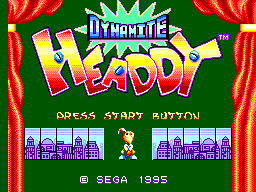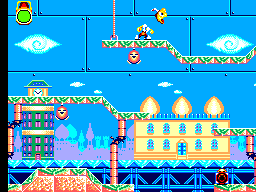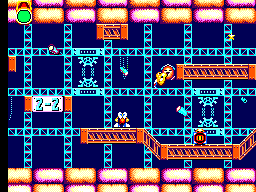|
 |
|
|
|
|
Review Information |
|
|
 |
|
|
Reviewer Name: |
Alexander Landgren |
|
|
|
|
|
|
Game Difficulty: |
Medium |
|
|
Difficulty Options: |
False |
|
 |
|
|
|
 |
|
|
|
|
Game Information |
|
|
 |
|
|
Full Title: |
Dynamite Headdy |
|
|
Year Released: |
1994 |
|
|
Game Type: |
Platform |
|
|
Max Players: |
1 |
|
 |
|
|
|
| Introduction |
|
|
| One of the more unknown SMS games is this 8-bit port of Dynamite Headdy, a quirky platformer for the Mega Drive which has become something of a cult classic over the years. It was only released in Brazil, but seems to have been intended for the US market since the credits show a whole team of Americans and the story is completely in English. Speaking of which, the story goes like this: The puppet Headdy (which the player controls) is visiting Puppet Town to see his friends Headcase, Hangman and Beau, but on arriving he discovers that the town has been taken over by the villain Dark Demon and his friends are nowhere to be seen.. so, he sets out to rescue his friends and beat the crap out of Dark Demon and there you have it. Not much of a storyline but that's to be expected from a retro platformer and personally I don't mind. What's more interesting is that the story for the original MD game was changed for the western audience, and then changed again for this version, apparently for the worse. Why this was done? I have no idea. |
| Gameplay |
| If you've played any other 16- to 8-bit ports then you should have an idea of what to expect from this one. It shares many elements with its older brother but they all feel somewhat toned down. However, the new elements are a breath of fresh air for Dynamite Headdy fans like myself, and some of them are quite well done. For example, nearly all of the bosses now have new behaviors and some of the easy ones from the MD version are now quite challenging. Unfortunately the opposite is true for some of the more challenging and unique ones, and the limits of the hardware become painfully obvious when facing the 8-bit version of bosses like the "almost 3D" Spinderella. In this version most bosses have a lot more hit points, but the patterns are simpler making them tedious to fight. Another thing that bugged me about the boss fights is that the arena was made extremely small by the placement of two huge pillars on each side of the screen. It doesn't really add to the challenge and it just looks bad. It also has to be said that the game is nowhere near as long as the MD version, most levels are over in under a minute, and the later stages have been skipped entirely, turning the game into a boss rush! Overall the gameplay is fine, but the second half of the game is frustrating due to the frequent and often tedious boss fights. |
| Graphics |
| As expected, the graphics are a step down from the 16-bit version. The colors look slightly washed out, there's no parallax (scrolling backgrounds) and a lot of small details have been omitted. Still, they look great for a SMS game and a nice touch is the addition of some brand new enemy sprites that have the same unique style of the original.
|
| Sound & Music |
| This area probably took the biggest hit in the conversion; sound effects are very tinny and not always appropriate to what is happening on the screen. The biggest annoyance is Headdys attack sound, which is similar to metal objects clinging against each other.
The music is well composed and appropriately cheerful, but it lacks the "oomph" of the MD version. There is a notable lack of bass and percussion is pretty much non-existent. To be honest I was expecting better from a developer like Treasure.
There are no voice samples in this version, and although I wasn't really expecting any it wouldn't have been impossible.. I remember hearing them even on the NES. |
| Controls |
| The controls are pretty much standard platform fare except for the way Headdy attacks enemies. This is done by shooting out his head at the enemy, disconnecting it from his body and giving it a quick head butt, which feels satisfying and looks funny. There are also other ways of attacking that you acquire (for a limited time) by picking up bonus heads lying around in the levels. These include a vacuum head (eliminating all enemies on screen and collecting all bonus items), a winged head (increases attack/walk speed), a "star" head (automatically shoots short range projectiles in all directions), a sleepy head (makes you go to sleep, not a good thing obviously) and a hammer head (boosts attack power).
One nice feature of the game is that when you fall down a pit, instead of losing a life Headdy is bounced back up and you only lose a hit point.
On the negative side, some heads were omitted and the hit detection is now very unforgiving. I found myself saying "That wasn't even close!" several times. |
| Replay Value |
|
| While the game offers some replay value in trying to find all secret bonus points (these are acquired by attacking a smiley face-like bonus), there isn't really any other reason to replay after you beat it. The game is short and linear, there are no difficulty options and the tedious boss rush at the end of the game will probably make you reluctant to play it again for some time. |
| Conclusion |
| Dynamite Headdy for the Master System is a toned down, shortened version of the original 16-bit game. However this doesn't mean it's not worth playing because it's still a fun, unique game with some new stuff not seen in the original and unlike some other systems the SMS doesn't exactly have a huge library of platformers. Obviously the cart is pretty hard to get a hold of so you may want to go with the Game Gear version instead. It is pretty much the same except for the superior color palette, a smaller screen and a lower difficulty level. |
|
|
|
|












